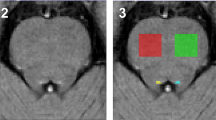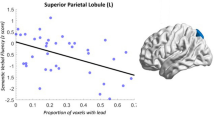Abstract
The aim of our study is to determine the pathological changes of white matter microstructure in patients with early post-stroke depression (PSD), and to investigate the association between white matter integrity examined by diffusion kurtosis imaging (DKI) and early PSD. Thirty-eight patients with acute cerebral infarction were selected, including 17 patients with depression (PSD group), and 21 patients without depression (N-PSD group). In addition, 20 normal healthy controls (NORM group) were selected. All were taken DKI scans. The white matter of the frontal lobe, temporal lobe, parietal lobe, occipital lobe, anterior limb of internal capsule, and posterior limb of internal capsule, in addition to the genu of corpus callosum and splenium of corpus callosum was selected as a region of interest (ROI). Selected parameters include fractional anisotropy (FA) and mean kurtosis (MK). Compared with N-PSD group and NORM group, FA value of the left frontal lobe and MK value of the bilateral frontal lobe, bilateral temporal lobe, and genu of corpus callosum in PSD group were decreased (P < 0.05). Our results indicated that the early PSD patients had white matter microstructure abnormalities in the frontal lobe, temporal lobe, and genu of corpus callosum. DKI provides a comprehensive brain imaging reference for detecting early microstructural damage of white matter in PSD patients, which can be used as an imaging biomarker to detect early PSD and its progression potentially.

Similar content being viewed by others
References
Zhao FY, Yue YY, Li L, Lang SY, Wang MW, du XD, Deng YL, Wu AQ, Yuan YG (2018) Clinical practice guidelines for post-stroke depression in China. Rev Bras Psiquiatr 40(3):325–334
Zhang N, Wang CX, Wang AX, Bai Y, Zhou Y, Wang YL, Zhang T, Zhou J, Yu X, Sun XY, Liu ZR, Zhao XQ, Wang YJ, on behalf of the Prospective Cohort study on Incidence and Outcome of Patients with Poststroke Depression in China (PRIOD) Investigators (2012) Time course of depression and one-year prognosis of patients with stroke in mainland China. CNS Neurosci Ther 18(6):475–481
Towfighi A, Ovbiagele B, El HN, Hackett ML, Jorge RE, Kissela BM, Mitchell PH, Skolarus LE, Whooley MA, Williams LS (2017) Poststroke depression: a scientific statement for healthcare professionals from the American Heart Association/American Stroke Association. Stroke 48(2):e30–e43
Li Y, Cao LL, Liu L, Qi QD (2017) Serum levels of homocysteine at admission are associated with post-stroke depression in acute ischemic stroke. Neurol Sci 38(5):811–817
Wang L, Tao Y, Chen Y, Wang H, Zhou H, Fu X (2016) Association of post stroke depression with social factors, insomnia, and neurological status in Chinese elderly population. Neurol Sci 37(8):1305–1310
Robinson RG, Jorge RE (2016) Post-stroke depression: a review. Am J Psychiatry 173(3):221–231
Sheline YI (2003) Neuroimaging studies of mood disorder effects on the brain. Biol Psychiatry 54(3):338–352
Liao Y, Huang X, Wu Q, Yang C, Kuang W, du M, Lui S, Yue Q, Chan R, Kemp G, Gong Q (2013) Is depression a disconnection syndrome? Meta-analysis of diffusion tensor imaging studies in patients with MDD. J Psychiatry Neurosci 38(1):49–56
Jensen JH, Helpern JA, Ramani A, Lu H, Kaczynski K (2005) Diffusional kurtosis imaging: the quantification of non-gaussian water diffusion by means of magnetic resonance imaging. Magn Reson Med 53(6):1432–1440
Grinberg F, Maximov II, Farrher E, Neuner I, Amort L, Thönneßen H, Oberwelland E, Konrad K, Shah NJ (2017) Diffusion kurtosis metrics as biomarkers of microstructural development: a comparative study of a group of children and a group of adults. Neuroimage 144(Pt A):12–22
Kamiya K, Kamagata K, Miyajima M, Nakajima M, Hori M, Tsuruta K, Mori H, Kunimatsu A, Arai H, AokiS OK (2016) Diffusional kurtosis imaging in idiopathic normal pressure hydrocephalus: correlation with severity of cognitive impairment. Magn Reson Med Sci 15(3):316–323
Adams HP, Bendixen BH, Kappelle LJ et al (1993) Classification of subtype of acute ischemic stroke definitions for use in a multicenter clinical trial, TOAST. Trial of org 10172 in acute stroke treatment. Stroke 24(1):35–39
Shi Y, Yang D, Zeng Y, Wu W (2017) Risk factors for post-stroke depression: a meta-analysis. Front Aging Neurosci 9:218
Williamson J, Nyenhuis D, Stebbins GT, Lamb D, Simkus V, Sripathirathan K, Wang C, de Toledo-Morrell L, Gorelick P (2010) Regional differences in relationships between apparent white matter integrity, cognition and mood in patients with ischemic stroke. J Clin Exp Neuropsychol 32(7):673–681
Choi S, Han KM, Won E, Yoon BJ, Lee MS, Ham BJ (2015) Association of brain-derived neurotrophic factor DNA methylation and reduced white matter integrity in the anterior corona radiata in major depression. J Affect Disord 172:74–80
Lätt J, Nilsson M, Wirestam R, Ståhlberg F, Karlsson N, Johansson M, Sundgren PC, van Westen D (2013) Regional values of diffusional kurtosis estimates in the healthy brain. J Magn Reson Imaging 37(3):610–618
Das SK, Wang JL, Bing L, Bhetuwal A, Yang HF (2017) Regional values of diffusional kurtosis estimates in the healthy brain during normal aging. Clin Neuroradiol 27(3):283–298
Bae JN, MacFall JR, Krishnan KR, Payne ME, Steffens DC, Taylor WD (2006) Dorsolateral prefrontal cortex and anterior cingulate cortex white matter alterations in late-life depression. Biol Psychiatry 60(12):1356–1363
Nobuhara K, Okugawa G, Sugimoto T, Minami T, Tamagaki C, Takase K, Saito Y, Sawada S, Kinoshita T (2006) Frontal white matter anisotropy and symptom severity of late-life depression: a magnetic resonance diffusion tensor imaging study. J Neurol Neurosurg Psychiatry 77(1):120–122
Friberg TR, Borrero G (2000) Diminished perception of ambient light: a symptom of clinical depression. J Affect Disord 61(1–2):113–118
Yasuno F, Taguchi A, Yamamoto A, Kajimoto K, Kazui H, Kudo T, Kikuchi-Taura A, Sekiyama A, Kishimoto T, Iida H, Nagatsuka K (2014) Microstructural abnormality in white matter, regulatory T lymphocytes, and depressive symptoms after stroke. Psychogeriatrics 14(4):213–221
Yasuno F, Taguchi A, Yamamoto A, Kajimoto K, Kazui H, Sekiyama A, Matsuoka K, Kitamura S, Kiuchi K, Kosaka J, Kishimoto T, Iida H, Nagatsuka K (2014) Microstructural abnormalities in white matter and their effect on depressive symptoms after stroke. Psychiatry Res 223(1):9–14
Funding
This study was supported by Doctor Wenzhen Duan of Johns Hopkins University School of Medicine.
Author information
Authors and Affiliations
Corresponding author
Ethics declarations
Conflict of interest
The authors declare that they have no conflict of interest.
Additional information
Publisher’s note
Springer Nature remains neutral with regard to jurisdictional claims in published maps and institutional affiliations.
Rights and permissions
About this article
Cite this article
Shen, XY., Fan, ZX., Wang, L. et al. Altered white matter microstructure in patients with post-stroke depression detected by diffusion kurtosis imaging. Neurol Sci 40, 2097–2103 (2019). https://doi.org/10.1007/s10072-019-03947-8
Received:
Accepted:
Published:
Issue Date:
DOI: https://doi.org/10.1007/s10072-019-03947-8




